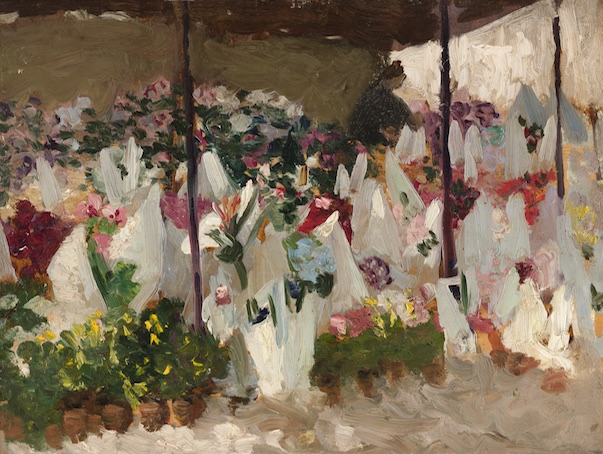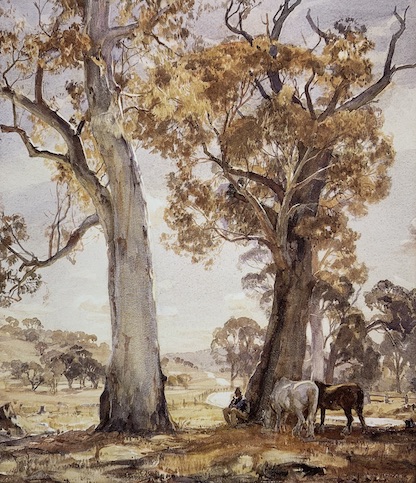MICHAEL McWILLIAMS 1956 –
Knee Deep in the Willows 2003
synthetic polymer on composition board
120 x 240 cm
Knee Deep in the Willows depicts a Friesian cow stranded in the mud and includes a frustrated farmer, hands on hips, on the other side of the river, contemplating the next move. The scene is inspired by the artist’s wanderings amongst the willows near his home in northern Tasmania, either fishing or with his dogs, where he is often confronted with a Friesian cow strayed from nearby grazing paddocks. Humans are rare in McWilliams’ painting. However, recent works introduce a human dialogue into his usual animal inhabited world.
A further treasure in this painting is a Thylacine or Tasmanian Tiger hidden in the shadows, a subtle conservationist statement from the artist who is passionate about their ongoing existence despite human intervention in their environment.
McWilliams’ craft has evolved from smaller scale works, particularly painted wooden panels or painting on furniture, to larger scale canvases where the landscape is the focus. Much of McWilliams’ knowledge of antiques was acquired during his teenage years when he travelled with his father on buying trips around Tasmania for their antique shop in Longford. McWilliams explains “I started painting on furniture simply because I liked the old timber, and it was at hand. I enjoy painting things that are close to me: water, trees and mountains, and familiar local animals.”
In many of his works, it’s a fleeting moment in nature that he captures and preserves. The viewer curious to see what is inside is presented with a delightful surprise. The element of hidden surprise adds an extra dimension to McWilliams’ painting. Look carefully at the artworks as those who undertake the treasure hunt will be rewarded with a glimpse of a thylacine, a favoured motif of the artist. Like many, he is incredulous that human intervention could cause the extinction of this species and hopes that perhaps there are still a few Tasmanian Tigers out there, hiding in the shadows as they are in his paintings. McWilliams has been interested in the Thylacine since he was a child, McWilliams explains “I’ve drawn it since I was small, and have always tried to imagine what it would be like to see one and to consider different relationships we could have, like having one for a pet. I try to imagine them into my life.”
The added element of fun and humour is a familiar trait in Michael’s work although it does not detract from his environmental message which prompts the viewer to question the relationship between humans and animals, whether wild or domestic; the relationship between native and introduced species; and the relationship between humans and the environment and the impact this has made for native species in particular.
AWARDS
2016 Winner, Children’s Choice, John Glover Art Prize for Tasmanian Landscape
2015 Winner, People’s Choice, John Glover Art Prize for Tasmanian Landscape, Tasmania
2014 Winner, People’s Choice, Hanger’s Choice, John Glover Art Prize for Tasmanian Landscape
2013 Winner, Children’s Choice, John Glover Art Prize for Tasmanian Landscape, Tasmania
2012 Winner, People’s Choice, Bay of Fires Art Prize, St Helens, Tasmania
2011 John Glover Art Prize for Tasmanian Landscape, Tasmania, finalist
2010 Wynne Prize for Landscape, Art Gallery of New South Wales, Sydney, Finalist
2010 John Glover Art Prize for Tasmanian Landscape, Tasmania, finalist
2008 Wynne Prize for Landscape, Art Gallery of New South Wales, Sydney, Finalist
2008 The Waterhouse Natural History Art Prize, The South Australian Museum, Winner
2008 John Glover Art Prize for Tasmanian Landscape, Tasmania, Hon. Mention
2008 Fleurieu Biennale Art Prize, South Australia
2007 John Glover Art Prize for Tasmanian Landscape, Tasmania
2006 John Glover Art Prize for Tasmanian Landscape, Tasmania, Hon. Mention
2005 The Waterhouse Natural History Art Prize, The South Australian Museum, Winner
2004 John Glover Art Prize for Tasmanian Landscape, Tasmania, Winner
1996 Tasmanian Art Award, Eskleigh, Perth, Tasmania, Winner
1994 Trust Bank Open Art Award, Launceston, Tasmania, Winner
COLLECTIONS
Queensland Art Gallery Danish Royal Family
Tasmania Museum and Art Gallery Powerhouse Museum, Sydney
Natural Trust of Australia (Tasmania) Parliament House, Canberra
Devonport City Art Gallery The Glover Society
Museum of South Australia Lauraine Diggins, Melbourne
Queen Victoria Museum and Art Gallery, Tasmania
Further information:
Michael McWilliams, Knee Deep in the Willows
Michael McWilliams Biography
Michael McWilliams artworks in the stockroom



